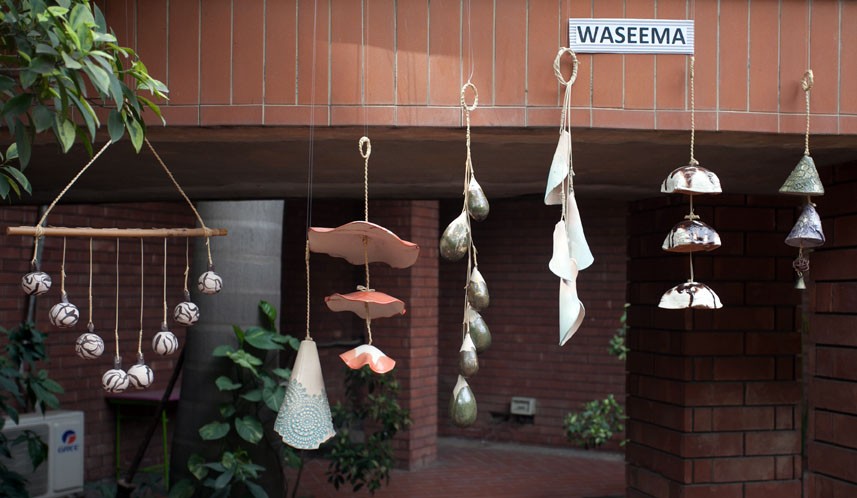
An open house event, ‘Our Clay Legacy’ showcased the exquisite works of noted ceramist Sheherezade Alam and other artists, from jewellery pieces to sculptural masks, functional lamps, bowls, pots and more

In this day and age, in case you do not get invited to an event personally or you miss the notification in the newspaper about upcoming events in your city, you have social media networking sites to do the needful. It was through Snapchat that I came across the videos of a display of exquisite ceramic art pieces, fetchingly titled ‘Our Clay Legacy.’ It had me hooked.
A Studio 90 Collective, headed by the internationally acclaimed ceramist Sheherezade Alam, the exhibition was held at a pre-partition residential place on Upper Mall, in the middle of sculpted trees, large manicured lawns, trails of marigold and rose petal on the pathway, and yellow and red flyers that hung from the outer wall of the house.
I as well as other visitors was witness to some earthly porcelain pieces made by Alam and a bunch of new and established artists she has mentored, namely Amjad Ali Daudpota, Afshan & Nosheen, Faiqa Lone, Ibtesam Salem, Kalsoom Mehmood, Amna Shariff, Rabia Oneeb and Waseem Saleem.
It was a two-day open house event, showcasing around 150 pieces, from jewellery to sculptural masks, functional lamps, bowls, pots and more.
Currently based in Lahore, Sheherezade Alam, 68, boasts a post-graduate degree in design from West Surrey College of Art & Design, UK. She is also the first person in South Asia to be elected to the International Academy of Ceramics in Switzerland.
Alam has mentored a generation of artists. She brought life to her studio in Lahore by conducting workshops, and "it blossomed into a collective" (her own words). ‘Our Clay Legacy’ was Studio 90 Collective’s first public show.
She also heads a cultural centre for children known as Jahan-e-Jahanara which is committed to development of artists and promoting our cultural heritage. Her work is currently exhibiting at the UNESCO funded "first-ever Special Exhibition" called ‘Re-discovering Harappa’ at the Lahore Museum.
"Studio 90 Collective’s very ethos is one which rests on the need to re-learn how to be intimate with clay so we can breathe life again," she said in a recent press release. "Our vision is to engage with the five elements -- earth, fire, water, air and ether -- to create vessels that relocate, reflect and preserve to continue what is vanishing, our clay heritage."
As I animatedly asked her about her pieces on display, especially the white porcelain ones, she Alam told me how her stay in China, in 2013, had mesmerised her with the amount of innumerable glazes. "It is idyllic for anybody to go to China for work. Everything is right there. One cannot stop working!"
She revealed that her husband, late Zahoorul Akhlaq, was a huge inspiration on her work. She fondly recalled the time she made collaborative art pieces with him where he did most of the carving and shaping and she worked mainly on the wheel.
While she was getting different kinds of moulds made, testing different colours, she thought that she ought to have "a colour." Instead of choosing it from a glaze shop in China where she could buy 500 colours, she simply looked up in the sky and decided to make her "whole series in the colour you see during daytime."
Some of her minimal pieces are egg- and cone-shaped, placed upside down and inspired from images of whirling dervishes.
Aspirants such as Ibtesam Saleem and Waseema Saleem, who had no formal training in ceramics, joined Alam’s Studio, experiencing her passion for clay. Ibtesam focused on garden lights whereas Waseema made some enchanting clay chimes.
Rabia’s neolithic inspired sculptural masks looked elegant. Faiqa Lone, a fashion designer by profession, seemed to conserve traditional embellishment techniques of the subcontinent. Her jewellery was made out of ceramic and stones with decoration applied in the form of glazes and stains.
On the other hand, Amna Shariff, known locally for her silver jewellery, displayed understated pieces reflecting significant Harappan motifs like unicorn, seal of the merchant, peepal tree leaves and birds, the tree of life etc.
I was intrigued to talk to Kulsoom Mehmood, a ceramist from Balochistan who is a National College of Arts graduate. Her work included planters, inspired from her native land.
Afshan and Nosheen, expert in nakashi, incorporated it with clay in jewellery, giving their ornaments a new perspective.
Amjad Ali Daudpota, another NCA graduate, focused on the revival of Kashikari art work.